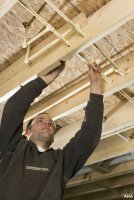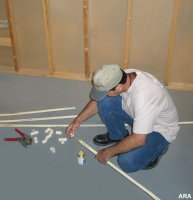 (ARA) – Ask anyone if they have ever taken on a home plumbing project by themselves and they will likely say that they have. But how involved was the project?
(ARA) – Ask anyone if they have ever taken on a home plumbing project by themselves and they will likely say that they have. But how involved was the project?
Many building professionals agree that plumbing is one of those tasks that typically looks a lot easier than it is. And while many savvy homeowners may have taken on a simple plumbing project, such as repairing a leaky faucet, fixing a toilet that keeps running, or even hooking up an ice maker, few consumers have actually plumbed their own bathroom or replaced old, corroded pipe.
That’s because plumbing has historically required various mechanical skills and the ability to operate expensive, cumbersome and complicated equipment. Even those more adventurous who have the know-how to plumb an extra bath may have avoided the task since a copper plumbing installation requires soldering. Difficult and messy, in some cases soldering is also downright risky, because it introduces an open flame into a confined area surrounded by wood joists and other flammable materials.
Today, however, you might be more likely to successfully replace a worn-out system or plumb a new bathroom, thanks to newer products and technologies that make the installation faster and easier – not to mention safer and less expensive. FlowGuard Gold CPVC plumbing systems, for instance, made of a high-performance plastic material, require only a handful of inexpensive cutting tools, a can of solvent cement, some knowledge of plumbing systems and proper procedures, and careful review of manufacturer instructions.
CPVC is a plastic piping system that allows easier installation than traditional copper or other metallic systems. As with any building material, you’ll need to handle CPVC properly and install it according to manufacturer instructions, and local and national building codes. Improperly installed CPVC systems can fail, as can ones that come in contact with chemically incompatible products during installation or at anytime during their service life. Keep the pipe and fittings away from certain oils and lubricants, wires and cables and some caulks (all Teflon tape is compatible). For more information, refer to your manufacturer’s instructions. To view a list of widely available compatible products, visit www.systemcompatible.com.
 Here’s a step-by-step guide to installing a simple CPVC system:
Here’s a step-by-step guide to installing a simple CPVC system:
- Start by cutting the pipe with a wheel type plastic tubing cutter, ratchet cutter or fine tooth saw. Using a chamfering tool, pocket knife or file, remove any burrs or filings; they can hinder proper contact between the pipe and fitting during assembly.
- Wipe the fitting socket and pipe end with a clean, dry rag to remove dirt and moisture. Then apply a heavy, even coat of one-step CPVC compatible solvent cement to the pipe end. Without adding more cement to the applicator, next apply a thin coat inside the fitting socket.
- Immediately insert the pipe into the socket, rotating the pipe 1/4 to 1/2 turn while inserting. The motion ensures cement is evenly distributed inside the joint.
- Hold the assembled pipe and socket for about 10 seconds, allowing the joint to set. You should see an even bead of cement around the joint. Wipe the excess cement from the pipe for an attractive, professional appearance. The joint will cure completely in about 10 minutes.
Like all piping material, FlowGuard Gold CPVC expands when heated and contracts when cooled, so you’ll need to allow for this. Expansion is mainly a concern in hot water lines. Changes in direction can usually accommodate this issue, but a long straight run of pipe may require an offset or loop. Check the manufacturer’s instructions for further details.
While the concept of CPVC piping is relatively new in the do-it-yourself market, the technology behind it has been around for decades. Professional plumbers have been using FlowGuard Gold CPVC pipe and fittings, for example, in residential, commercial and industrial settings for 50 years. CPVC piping has proven to be reliable, quiet, energy-efficient and more budget friendly than costly metal systems. Plus, the plastic piping minimizes condensation and concerns about water contamination.
It’s important to note, however, that even with the newer, user-friendly products, a moderate level of plumbing knowledge is required. Total plumbing ignorance may create silly mistakes that can turn into big, costly headaches. Do your homework before tackling any plumbing project. Regardless of what product or material you’re installing, always be sure to research local plumbing codes and fully read all manufacturer’s instructions before getting started.
For more information on the easy-to-install FlowGuard Gold CPVC plumbing system, visit www.flowguardgold.com.
Courtesy of ARA Content
